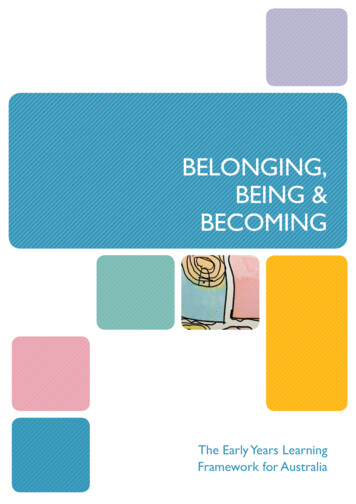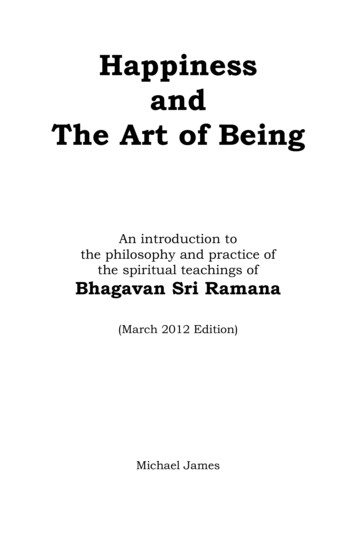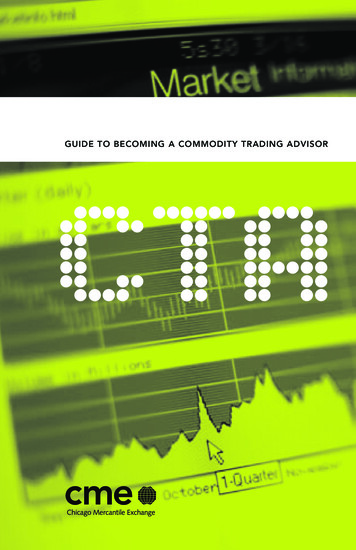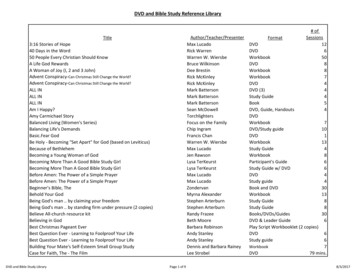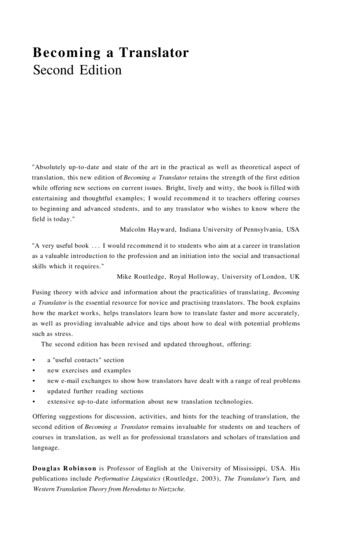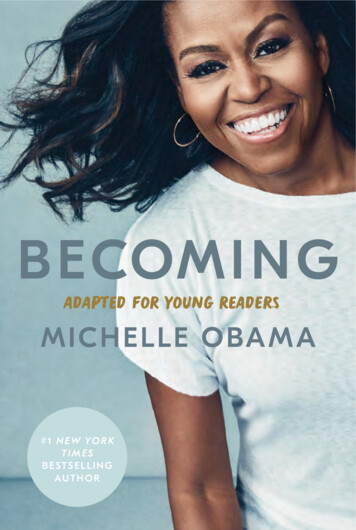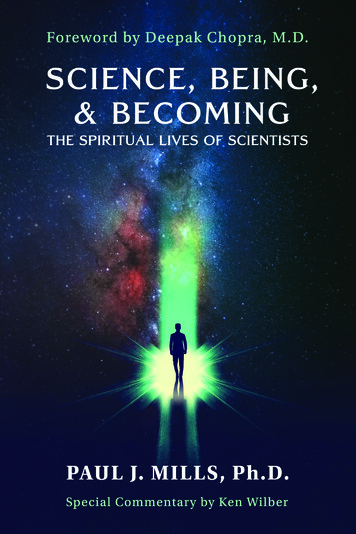
Transcription
SCIENCE, BEING,& BECOMINGThe Spiritual Lives of ScientistsPAUL J. MILLS, Ph.D.
Copyright 2022All rights reserved.This book or part thereof may not be reproduced in any form, stored in aretrieval system, or transmitted in any form by any means-electronic, mechanical,photocopy, recording, or otherwise without prior written permission of thepublisher, except as provided by United States of America copyright law.The information provided in this book is designed to provide helpful informationon the subjects discussed. This book is not meant to be used, nor should it beused, to diagnose or treat any medical condition. The author and publisher arenot responsible for any specific health needs that may require medical supervisionand are not liable for any damages or negative consequences from any treatment,action, application, or preparation, to any person reading or following theinformation in this book.References are provided for information purposes only and do not constituteendorsement of any websites or other sources. In the event you use any of theinformation in this book for yourself, the author and the publisher assume noresponsibility for your actions.Books may be purchased through booksellers or by contacting Sacred StoriesPublishing.Science, Being, & Becoming: The Spiritual Lives of ScientistsPaul J. Mills, Ph.D.Tradepaper ISBN: 978-1-958921-05-0Electronic ISBN: 978-1-958921-03-6Library of Congress Control Number: 2022942596Published by Light on Light PressAn imprint of Sacred Stories Publishing, Fort Lauderdale, FLPrinted in the United States of America
ContentsForeword Deepak Chopra, M.D. . iSpecial Commentary - Recognizing and Evolving our Spiritual and Human Natures Ken Wilber . ixIntroduction . xviiSpotlight - Perspectives on Transpersonal, Metaphysical, and Mystical Experiences Kyriacos C. Markides, Ph.D. . xliiiChapter 1: The Need to Transform Materialist Science . 1Chapter 2: Heeding the Call: The Making of a “Spiritual Scientist” . 17Spotlight - Consciousness Evolves Toward Wholeness and UnityRobert Atkinson, Ph.D. . 93Chapter 3: Mentors and Other Allies . 99Chapter 4: From Trials to Commitment and Transformation.133Chapter 5: Giving Back and the Next Generation.145Spotlight - Advice to Scientists Thinking of Pursuing the JourneyEben Alexander, M.D.175
Chapter 6: Putting into Perspective the Consciousness DevelopmentJourney.181Spotlight - Compassion as a Catalyst and Compass for Self-transcendingExperiences along the Journey of Consciousness DevelopmentDusana Dorjee, 215About the Spotlight Authors.223About the Author.225
IntroductionThe Galactic CenterAfew years ago, I was with a group of friends discussing what wasthen a current astronomical event called the Galactic Alignment.This is when the earth and our Sun’s positions change in relation to thecenter of the Milky Way Galaxy when we pass through what is called the“Galactic Plane.” This event occurs every 26,000 years. It was all news tome, as other than the cycle of our own moon, I typically didn’t track suchthings. In addition to the astronomical features of what had occurred, ourconversation also included somewhat esoteric astrological aspects, and wewondered how our new position in relation to the Galactic Center mightaffect us here on earth, if at all.After the conversation ended, I decided to sit and meditate on whatwe had been discussing. This was a contemplative kind of meditation,something I like to do to have more insight into a topic that I’ve justlearned about. I closed my eyes with the simple intention of wanting tobetter understand what we had been discussing, to possibly glean somenew insights. Within a moment’s time, I found myself encountering a
SCIENCE, BEING, & BECOMINGvast consciousness, a “consciousness mind” if I may put it that way. Thisconsciousness was utterly foreign to anything I had ever come acrossbefore. It began to communicate with me telepathically, i.e. I heard nowords, but I started receiving images in my mind.The first thing it communicated was that it had no interest in individualhuman beings but was keenly interested in humanity itself. I immediatelythought this was odd in the sense that my study of religions indicates thatbeings greater than ourselves, such as the great devas and godheads, areindeed interested in helping human beings. People routinely pray to suchbeings for intercessions where possible and appropriate. This consciousnessindicated it had been watching the development of humanity for eons andthat one day in the future, humanity would come into its own in termsof fulfilling the reason it was created. It was that future event that thisconsciousness was interested in and waiting to occur.As I wondered what this future event might be, the consciousnesscommunicated to me that humanity is unique in the universe and that,after further developing our consciousness, one day, humanity willmanifest something that has never before been manifested in our physicaldimension. As it communicated this into my mind, I saw an image of theearth from space, and while it “spoke” there emerged spreading across theglobe a vast white, goldish-colored light that will one day be producedby a more evolved collective consciousness we call humanity. It was abeautiful and inspiring sight. What is it that will one day be manifested?Acknowledging what I consider my limited capacity to fully understandthe vastness of that consciousness I encountered, what I understand willbe manifested into physical creation is love itself. Love, that force of andbehind creation, is to come into physical existence itself.This was a momentous experience for me. With a firmness in mymind, I thought that this was indeed a future destiny of humanity. I startedxviii
Introductionlooking for books that might help me understand what I had experienced.I eventually found a few that speak about vast consciousness minds,including Jude Currivan’s The Cosmic Hologram: In-formation at the Centerof Creation, Carl Johan Calleman’s The Nine Waves of Creation: QuantumPhysics, Holographic Evolution, and the Destiny of Humanity, and workby the great Indian Sage Sri Aurobindo, who in The Life Divine describesvast levels of mind consciousness that are beyond typical human mindconsciousness but of which we are destined to one day embrace. I’ll sharemore on this later, but after reading The Life Divine, I wondered if the vastconsciousness I encountered was what Aurobindo calls the “Overmind,”or perhaps it was the “Supermind,” which is a level of mind beyond theOvermind. I wondered, too, whether that transformational vision I hadof the earth’s future corresponded to what Aurobindo describes as theeventual “descent of the divine into the world.”I also began to ponder whether this future event is definitely going tooccur—or is it a “probable”, a “maybe” depending on a host of variablesunknown to me. If the latter, I wondered if it is a responsibility of eachof us as individual human beings to foster humanity’s eventual spiritualawakening to help that eventual manifestation of love. I found myselfwondering, “What have I as a biomedical scientist been doing to help orhinder this eventual development of humanity?”More broadly, I wondered, “What are the biomedical sciences and thescientists working in them doing in terms of helping or hindering this futuregoal of humanity? Are we in service to humanity’s future advancement ornot?” I was aware that the vast majority of the scientific endeavor is highlymaterialistic, with metaphysical and mystical considerations outrightrejected as nonexistent; love itself is considered only an emotion and eventhen, not routinely studied. Yet, I also knew there were biomedical scientists,including some of my own colleagues, working within the mainstreamxix
SCIENCE, BEING, & BECOMINGsciences who have deeper spiritual understandings of who we are as peopleand of the conscious universe at large. I also knew that many of them wereworking in their own way to bridge the so-called “gap between scienceand spirituality.” They were working to overcome the materialism and itschoking effects on the progress of the sciences that could ultimately helpsupport a future spiritual life of humanity.This is the primary reason for my writing this book. I wanted tounderstand what such scientists experience in terms of insights into theirown spiritual nature and how those insights and experiences influence theirscientific work. I thus set about reaching out to scientists and asking if Icould interview them about their spiritual life. The book is a compilation oftranspersonal, metaphysical, and mystical experiences and explorations ofleading senior national and international scientists and clinician scientists,as well as more junior scientists who are at the beginning of their scientificcareers.Transcendental Meditation and The Oak TreeMy own spiritual journey, if I may call it that, started in 1972 while I wasin high school when I learned to practice transcendental meditation (TM).TM was introduced to the West by Maharishi Mahesh Yogi, and back then,it was sweeping the country, much in the way mindfulness meditation hasdone in more recent times. I was drawn to meditation because I heard itcould help me unfold my potential. I was also drawn to it for another lessconcrete reason: it simply seemed like a good thing to do.I had attended an introductory lecture on TM, and the next step wasto individually meet with the teacher and learn the actual meditationtechnique. The TM teachers lived in an old stone farmhouse just down theroad from where my family lived in the small town of Pineville, in Bucksxx
IntroductionCounty, Pennsylvania. In the room where I was to learn to meditate wasa painting of the Maharishi’s guru, Swami Brahmananda Saraswati. TheSwami had been a highly significant spiritual figure in India, serving as theShankaracharya of the Jyotir Math monastery in Northern India. After abrief ceremony, my TM instructor, Robert Wallace, gave me my personalmantra (or sound) and told me to repeat it quietly in my mind. I followedhis instructions and very quickly found myself in a deeply relaxed, peaceful,and expansive place. After some time, he told me to stop repeating themantra and open my eyes. When I opened my eyes, I looked at the paintingof the Swami, and then at Robert, and asked him if the Swami had givenhim the mantra to give to me. He smiled and said no.My first few months of practice, while pleasant and deeply relaxing,were otherwise uneventful. That changed one day when I went outside tomeditate under a large oak tree near our home in the countryside. Thetree was situated in the middle of a nearby field of wild grasses. It wasmidafternoon on a warm summer day. A few minutes into the meditation,my awareness suddenly shifted, and I found myself hovering above mybody, looking down upon myself seated under the tree. I could clearly seethe top of my head, my shoulders, and my back, as well as the groundaround me, which was mostly covered in dried leaves. It was initiallyshocking, but I quickly settled into it.Although it was a completely new experience for me, it at the sametime felt familiar. While looking down upon my body, I found myself inan expansive sea of silence, peace, and tranquility. It was both me, Paul,having the experience and a much bigger “me,” the one to whom it all felt sofamiliar and okay. After a few minutes, I was “back in my body.” I sat therein awe; I had never heard of such a phenomenon. In the TM introductorylecture I had attended just prior to learning the actual meditation technique,my teacher Robert hadn’t mentioned this as a potential experience. Rather,xxi
SCIENCE, BEING, & BECOMINGthe lecture focused on things like quieting the mind and experiencingrelaxation.Over the following weeks, as I pondered the experience, a seed wasformed that would eventually direct me to a scientific career. I decidedI wanted to learn the methodologies of science to study how meditationworked and to better understand our human potential. I particularlywanted to know about the capacity and limits of further developing ourconsciousness, what lies beyond the normal everyday perception of oursense of self and mindbody. Prior to that meditation under the tree, I hadnot known we could experience consciousness without boundaries. I alsowanted to understand how is it that I was both the “Paul” I had alwaysexperienced myself to be and yet also a much bigger “me” to whom theexpansive and peaceful experience was all so familiar. Who was the “real”me, or were both me? In addition to helping me understand who I was,I wondered if conducting scientific studies on meditation would helpencourage others to learn it too.States of ConsciousnessThat experience under the oak tree galvanized me to become devoted tomy meditation practice. I also made a commitment to myself to learnall I could about the nature of such consciousness experiences. As partof that commitment, I devoured books on the topic, including books bythe Maharishi. In his books The Science of Being and Art of Living 4 andCommentary on The Bhagavad Gita, he describes seven different statesof consciousness that are available to human beings. These included theordinary states of consciousness we are all familiar with, i.e., waking,dreaming, and deep sleep, but also an additional four “more elevatedstates.” Each of these elevated states is characterized by the experiencexxii
Introductionof “pure unbounded awareness,” yet the context of what that awarenessexperiences is markedly different in each of the four states: Transcendental consciousness. The state of pure unbounded innerself-awareness, the true Self, without perception of the other threeordinary states of consciousness. Cosmic consciousness. The state of pure unbounded innerself-consciousness found in transcendental consciousness, yetsimultaneously maintained while experiencing any of the otherthree states of ordinary consciousness of waking, dreaming, anddeep sleep. This state is often called “witnessing consciousness”because of the perceived disparity of the unbounded inner selfconsciousness while at the same time perceiving the apparentbounded limited objects in everyday life. Divine consciousness. This state of consciousness is considered apartial resolution of the disparity of cosmic consciousness in thesense that the separation and witnessing of cosmic consciousnessbegin to change such that perceptions that had appeared to bespatially bounded objects in everyday life now begin to be seen fortheir true nature as unbounded consciousness. Unity consciousness. Unity represents a resolution of the illusionthat the infinite unbounded Self is any different from all that isbeing perceived. The infinite is seen in each and every object ofperception and is known to be what those objects are. Despitealso seeing the unique appearance and form of every object ofperception, it is simultaneously seen as consciousness itself. Thereis no longer a sense of witnessing, no longer any duality; all is seenas one infinite totality, as Self. Prior experiences of separationxxiii
SCIENCE, BEING, & BECOMINGare now known to have been illusion. The Maharishi also spokeof a further refinement of unity consciousness called Brahmanconsciousness. The Sanskrit word Brahman refers to the eternalabsolute reality, the totality of all existence. Brahman consciousnessthen is the experience of the totality of all existence, its essentialoneness. Interestingly, Maharishi said that the transition from thestate of unity to Brahman consciousness takes place on the level ofthe mind. It is some kind of realization on the level of the intellectthat enables one to come into this state of experience.What Maharishi taught was not new. In fact, many meditationtraditions provide insight into what are often called non-ordinary, unitivestates of consciousness. In his Special Commentary for this book, KenWilber shares such insights from other traditions, including the fourthstate called turiya and the fifth state beyond turiya called turiyatita. I foundreading Maharishi’s books particularly relevant to my experience under theoak tree that day. For the first time, I could put a name to my experience,and I knew someone else had experienced it too. The teachings providedme with an important roadmap as the years unfolded and I continued toexperience further transformations of my experience of consciousness.END OF EXCERPT OF INTRODUCTIONxxiv
Chapter 1The Need to TransformMaterialist ScienceContemporary science is based on the philosophy of materialism,which claims that all reality is material or physical.— Rupert SheldrakeWhen Joseph Campbell visited India in 1954, he had alreadywritten The Hero with a Thousand Faces, which recognizes theuniversal “monomyth” motif of adventure and transformationfound in nearly all of the world’s cultures. He decided he wanted to meeta major guru, so he went to see a celebrated teacher named Sri KrishnaMenon who lived in Trivandrum. As soon as Campbell sat down, theteacher asked him, “Do you have a question?”Campbell learned later that he had the good fortune of asking the samequestion that Sri Krishna Menon had first asked his own guru: “Since allis the divine radiance, how can we say ‘no’ to ignorance, to brutality, toanything if the universe is a manifestation of divinity?” If that were the case,wouldn’t it mean that “even the base elements of the world are manifestingdivinity?” The teacher replied, “For you and me, the way is to say yes.” Itconfirmed for Campbell his thoughts that anything that fosters separationis false.27
SCIENCE, BEING, & BECOMINGUnfortunately, the materialistic sciences do just that—foster falsedualities of spirit and matter where none in fact exist. Modern sciencecasts a judgment upon the nature of the world and discounts the realmof inquiry called the spiritual. One of my interviewees, Julia Mossbridge,beautifully stated that “Judgment is observation without love.” The greatTibetan teacher Djwhal Khul considered judgement “humanity’s greatestheresy.” Our sciences foster duality and judgment - observations withoutlove - resulting, as we will see, in numerous downstream negative personal,social, and environmental consequences.Campbell left this teacher with new insight and a new way to meditate.He was instructed by the guru to focus his attention between his thoughts.From there, he could gain an intuitive flash of the source field out of whichall thoughts and energies arise, including those that structure his ownsense of egoic identity. The goal was to move between apparent opposites:stillness and thought, good and evil, up and down, the seemingly materialand spiritual, into an experience of unity.Campbell was on the journey on which all scientists embark to findanswers to fundamental questions of self-identity, life, and the broaderuniversal existence. Many scientists hear the call of an ephemeral experiencethat makes them wonder who they are and how the world works. They thenthirst for knowledge and experience that will let them discover the answersfor themselves. They choose the scientific path of knowledge and inquirybecause it is considered a reliable way of discovering valid knowledge.Since humanity’s inception, we have been on a path of seekingand attaining increasing amounts of knowledge. Be it Adam and Eveapproaching the Tree of Knowledge in the Garden of Eden, or Prometheusstealing knowledge of fire from the Greek gods, we are driven to learn. Theso-called Scientific Revolution in 1593 marked the beginning of scientificmethodologies as the dominant path to attaining new knowledge. While2
The Need to Transform Materialist Sciencethere have been clear benefits t o the emergence o f t his way of g ainingknowledge, there have also been significant d ownsides t o h ow i t h asultimately progressed.END OF EXCERPT OF CHAPTER 13
Chapter 2Heeding the Call:The Making of a“Spiritual Scientist”We must have perseverance and above all confidence in ourselves. We mustbelieve that we are gifted for something and that this thing must be attained.— Marie CurieWhat prompts an individual to become a scientist and takeon this pursuit? Throughout the conversations I had withmy fellow scientists, I found remarkably different reasons.Some were deeply sensitive to nature as a child or had innate intuitive ortelepathic abilities. For others, it was trauma, a mental illness, or a deathin the family. Still others first encountered the mystical through the useof psychedelics or, like me, pursuing a meditation practice. Still othersaccessed the mystical through a profoundly deep desire to know themselvesand their place in the universe.Varied as these reasons were, they were pivotal moments in eachinterviewee’s life—moments that opened the door to their journey. It wasthe proverbial “heeding the call to adventure” stage of the monomyth.A consistent feature among them is that they were all deeply personalexperiences. The memory of these experiences and the lasting imprints
SCIENCE, BEING, & BECOMINGthey left on their consciousness continue to be guiding forces through theirlives.The Call During ChildhoodFor Rudolph (Rudy) Tanzi, his opening into the metaphysical wasn’tthrough trauma, drugs, or meditation, but through playing a game with histwin sister. When they were children, they played a game where they triedto convince each other that nothing existed. They would begin the gamewith a series of questions to each other, “What if there was no house?”“What if there was no neighborhood?” “What if there was no city?” “Whatif there was no earth?” The questions would go on and on until they arrivedat the question, “What if there was no universe?”If they were successful with the game, as they arrived at the place wherenothing indeed existed, not even the universe, they would get a uniqueexperience in the pit of their belly that they called the “flip.” They wouldrace each other to see who could get to the flip first, to experience thefeeling that absolutely nothing existed.Rudy told me that his experience of the flip was deeply visceral andenergetic in how it affected his consciousness. It was something beyondanything he could experience in any other circumstance in his life. It wasn’tuntil many years later that he was able to categorize the flip experience as awindow into the metaphysical.The more they played the game and experienced its rewards, themore Rudy’s interests in the mystical grew. He said, “The game led me towonder, ‘What is consciousness, what is awareness, what is the universe?’”He eventually decided that since science allows us to measure what meetsthe eye, perhaps if it could also lead him to what lies beyond the senses,18
Heeding the Call: The Making of a “Spiritual Scientist”he should learn the scientific method in his quest to understand themetaphysical.He said those earliest passionate interests and his willingness toexplore the metaphysical made him a different type of scientist, helpinghim maintain an open mind and keep thinking about the big questions. Hesaid it kept him thinking “outside of the conventional box of science.” Healso shared that he’s “always been titillated by the idea of new discovery. Ilove when you discover something new and for that moment, or for thatday or perhaps a few weeks, you’re the only person that knows somethingreally important about the universe that nobody knew before.”Science fiction, too, became a passion because, through it, he could learnabout the paranormal, telepathy, and mediumship. He read voraciously onthese topics. He recalled that his friends wondered, “What’s wrong withRudy?” because all he was interested in talking about were these strangethings.I met Rudy through Deepak Chopra. He and Deepak had just publishedthe book Super Genes, and Rudy came to the Chopra Center for Wellbeingin Carlsbad, CA, to give a talk. We later worked together on the SBTI StudyI wrote about in the Introduction. Rudy is an amazingly talented humanbeing. In addition to being a top-tier scientist—having discovered threeof the four genes linked to Alzheimer’s disease—he’s also a professionalmusician, having played with the rock band Aerosmith. Some years ago,he appeared in a GQ Magazine photo shoot for a campaign called “RockStars of Science.’’ Today, he is the Joseph P. and Rose F. Kennedy Professorof Neurology at Harvard University and Director of the Genetics andAging Research Unit. In addition to the Chopra Center, he’s shared hisexplorations of consciousness at numerous meetings around the world,including the annual Science and Nonduality conference.19
SCIENCE, BEING, & BECOMINGOther interviewees had a different kind of sensitivity as children, not ina form that manifested while playing a game, but a sensitivity to the naturalworld around them, prompting in them a deep yearning to understand theworld and their relationship to it.Neil Theise is a Professor of Pathology at NYU Grossman School ofMedicine, a diagnostic pathologist who also does academic work instem cells, liver disease, and the anatomy of the human interstitium, and“dabbles in complexity theory.” Neil grew up in a household that was opento spiritual exploration. He said that religion “was a lovely thing as it waspracticed by my family. It was very rich, warm, and non-punitive.” Hisfather was actually part of the Kindertransport, or Children’s Transport,a rescue effort between 1938 and 1940 that brought thousands of refugeechildren, the majority of them Jewish, to Great Britain from Nazi Germany.“That’s how he survived.” His father’s parents, however, did not survive. “Alot of our family was killed. I grew up in a world of survivors where therewas an imperative to find a way to flourish.”As a young child, Neil experienced that world with “a deep-felt sense.”He felt the world was highly personalized and rich with feeling. “If I kickeda rock, and it went into a sewer, I felt bad because the rock would beunhappy. If I found ants in our home, I would carry them outside because Ididn’t want my mother to notice, since she would then call the exterminator,and there’d be an ant Holocaust.” That intimacy with the world turned intocuriosity, which eventually turned toward medicine and the sciences.His mother was from England, from a family with a long line of rabbisgoing back to the Middle Ages—a true lineage, I thought. She “operatedin the world through magical realism, which included her being able tocommunicate with the deceased.” He explained, “Magical realism wasn’ta style; it was how my forebears experienced the world, and my mother20
Heeding the Call: The Making of a “Spiritual Scientist”very much experienced it that way. There was the emotional sense of beingconnected to God, which included ritual, holiday celebrations, and familyrelationships.”Magical realism is something that Neil, too, has direct experiences with.I found that linkage interesting because there is evidence that lineages cancarry abilities such as clairvoyance and clairaudience through generations.After his mother passed away, Neil told one of his mother’s friends thathis mom had recently been communicating with the deceased. The friendreplied, “Your mother was always seeing dead people!”One of Neil’s dearest friends, Richard, died during the AIDS epidemic.“Before he died, I said to him, ‘Look, you will probably have more importantthings to do, but if, after you’re dead, you find yourself aware of things andable to interact with this world, and don’t have anything more importantto do, I’d love to have you around for a year as a guardian angel.’” Richardpromised he would stick around if he could. Neil shared that he did stickaround. “He was a very vivid presence for me.”While Neil was in college, a cousin from Canada visited and gave hima copy of James Michener’s The Source, which describes the rise of Jewishmysticism during the medieval period. He had never heard of Jewishmysticism; Michener’s novel opened him to those new ideas.As he learned about Jewish mysticism, he was moved by the idea that,as a human, we can experience God’s perspective of the world, particularlyas he contemplated the Jewish Holocaust. He then related a story of a walkon the beach with a friend shortly after gaining these newfound insightsfrom Jewish mysticism. As he related the story to me, he choked up. Whilewalking, he was sharing with his friend what he was learning about Jewishmysticism, and he had a sudden insight. He said to his friend, “The idea isthat if a human can have an experience of God’s perspective of the world,then everything can make sense.” He w
Transcendental Meditation and The Oak Tree My own spiritual journey, if I may call it that, started in 1972 while I was in high school when I learned to practice transcendental meditation (TM). TM was introduced to the West by Maharishi Mahesh Yogi, and back then, it was sweeping the country, much in the way mindfulness meditation has

